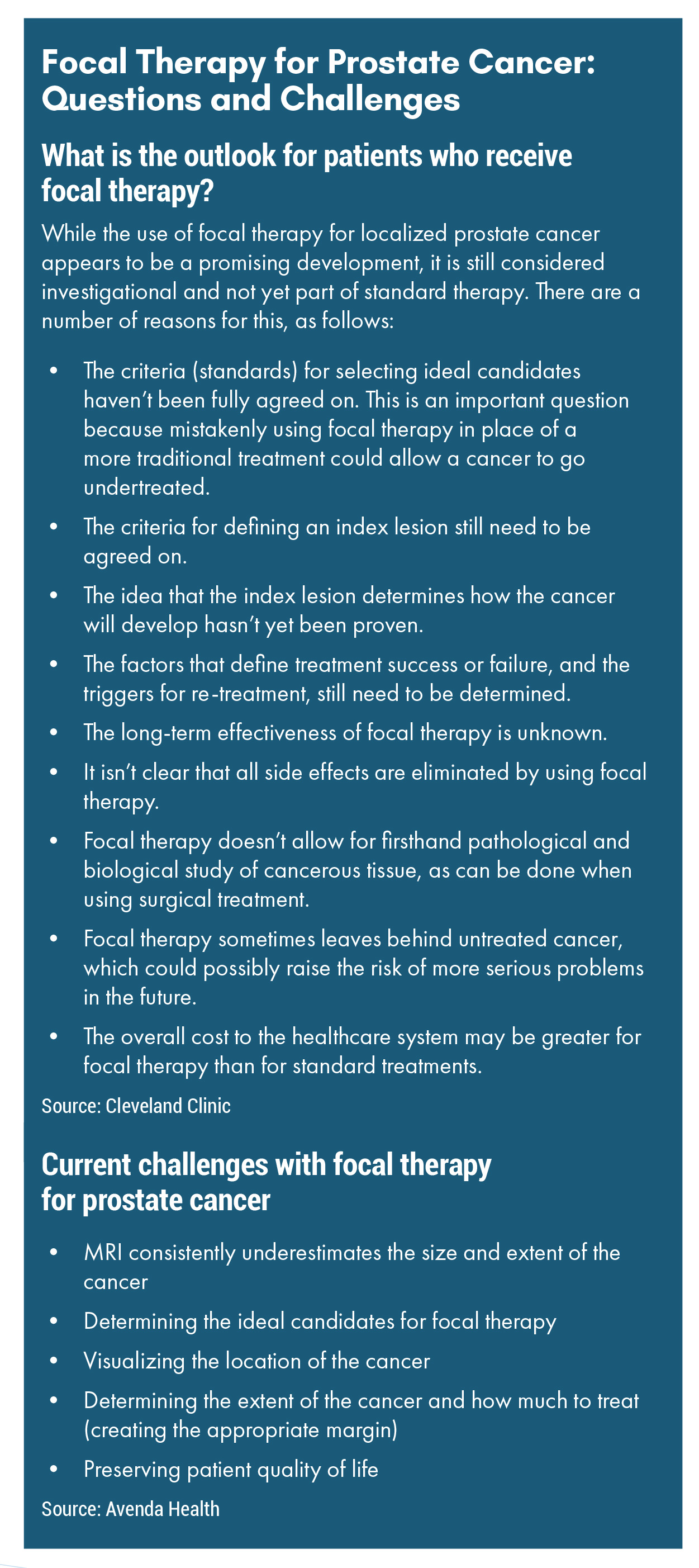ARTICLE SUMMARY:
Recent advances in image fusion and AI-based guidance and mapping could help usher in a new era for prostate cancer patients, one in which the disease is routinely managed using highly targeted, individualized focal ablation therapy designed to tackle the cancer while preserving the patient’s quality of life.
Prostate cancer (PC) is the second most common male cancer worldwide, with more than 1.4 million new cases diagnosed globally each year and more than 250,000 in the US alone. Surgical removal of the prostate (prostatectomy) or radiation therapy are the standard of care, but both are associated with significant side effects, including impotence and incontinence. Although surgical technique and technology have evolved considerably over the years—including the introduction, more than two decades ago, of robotic-assisted prostatectomy, now considered the gold standard for localized disease—the pace of innovation has been frustratingly slow and PC remains a challenging disease to manage. But the field is now poised for a major shift, as ongoing advances in imaging and AI-based guidance and mapping promise to help bring safer, more individualized, and less-invasive treatment options to the forefront.
Most cases of PC diagnosed in the US are found in the early stages, while the disease is still localized. That’s good news for patient survival; but many men with localized PC, faced with few appealing treatment options, still struggle to choose a treatment path. According to the 1,300-patient, multicenter Prostate Cancer Outcomes Study, more than half of men with localized PC who undergo prostatectomy experience impotence following their surgery and about 40% have some degree of urinary incontinence. Likewise, radiation therapy can also damage the blood vessels and nerves that impact erectile function. According to the Prostate Cancer Foundation, radiation therapy has less of an effect on potency in the first five to 10 years following treatment, but the impact is often delayed and by year 15 impotence rates are similar to those seen in patients treated with surgery. Doing nothing (watchful waiting) is another option, as PC is often slow growing, but watchful waiting also carries risk, particularly for those unlucky enough to have an aggressive form of the disease.
For the past 15 years or so, researchers have been investigating a more patient-friendly, focal treatment approach for localized PC, using energy-based tools delivered percutaneously to ablate the “index lesion” —the tumor visible on MRI—while leaving the remaining prostate tissue intact. By targeting only the index lesion, in something akin to a “prostate lumpectomy,” the aim is to destroy the bulk of the cancer while preserving as much organ function as possible, thus minimizing procedure-related side effects and maintaining patient quality of life.
 This focal approach is still considered investigational (no more than 10% of PC procedures are currently performed this way), and many challenges and unanswered questions remain (see box). However, recent efforts to employ new image fusion technologies and AI-based tissue mapping algorithms to improve focal ablation procedure planning and guidance are beginning to bear fruit and could help bring this treatment option into mainstream use. These high-tech solutions have the potential to improve the safety, ease, and efficacy of focal PC ablation, and for the first time, will enable focal ablation to be performed outside of the MRI machine, in an office-based setting under local anesthesia, an advance that could usher in a sea change for the management of early-stage PC.
This focal approach is still considered investigational (no more than 10% of PC procedures are currently performed this way), and many challenges and unanswered questions remain (see box). However, recent efforts to employ new image fusion technologies and AI-based tissue mapping algorithms to improve focal ablation procedure planning and guidance are beginning to bear fruit and could help bring this treatment option into mainstream use. These high-tech solutions have the potential to improve the safety, ease, and efficacy of focal PC ablation, and for the first time, will enable focal ablation to be performed outside of the MRI machine, in an office-based setting under local anesthesia, an advance that could usher in a sea change for the management of early-stage PC.
Follow these links to our profiles of two companies making strides in this area—Avenda Health, which has combined image fusion with AI-based prediction and mapping technologies to precisely target the cancer’s location, and Koelis, which integrates real-time 3D ultrasound imaging with proprietary MRI-ultrasound fusion technology that automatically compensates for patient movement and prostate deformation during the biopsy procedure.
.

